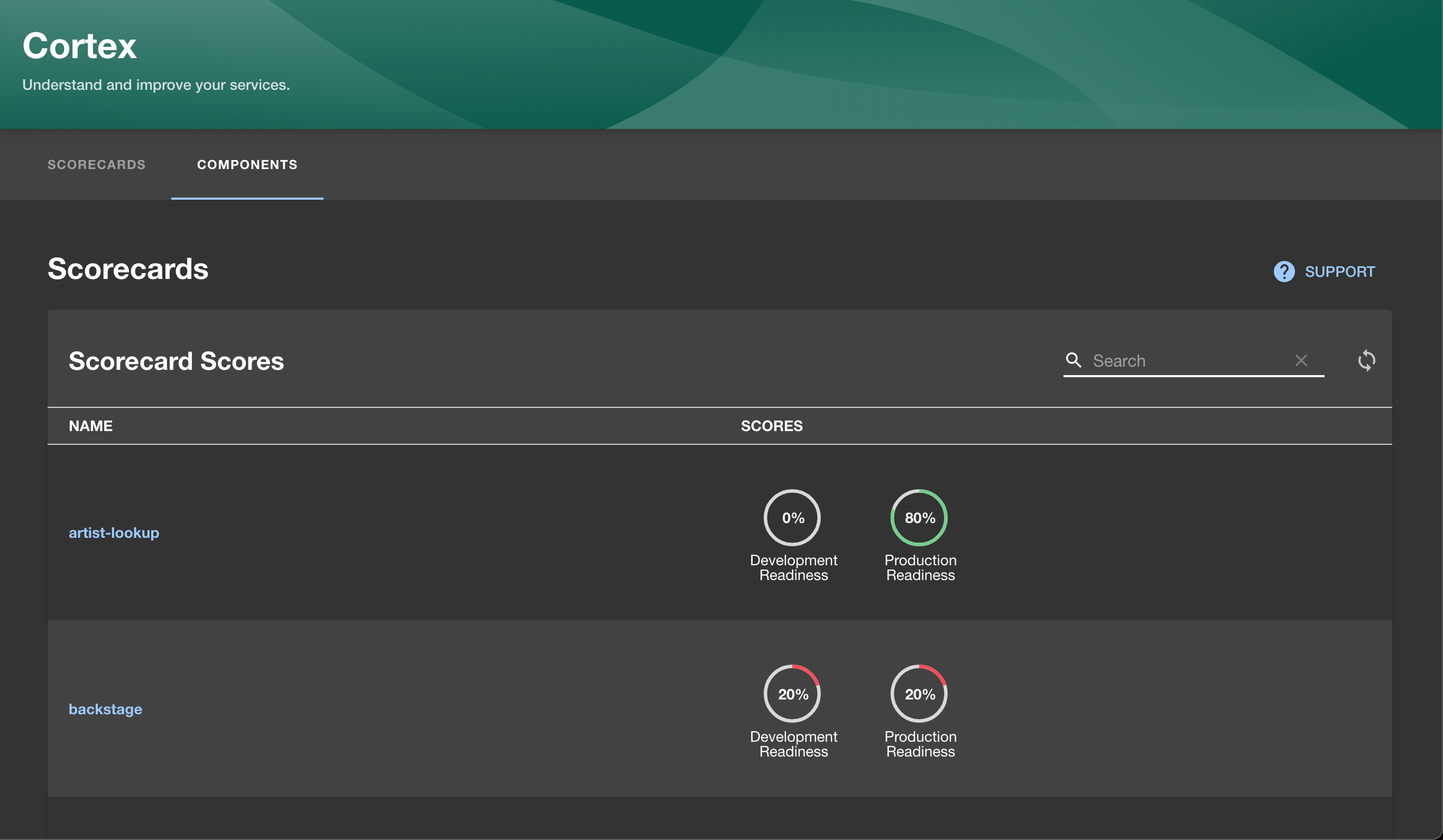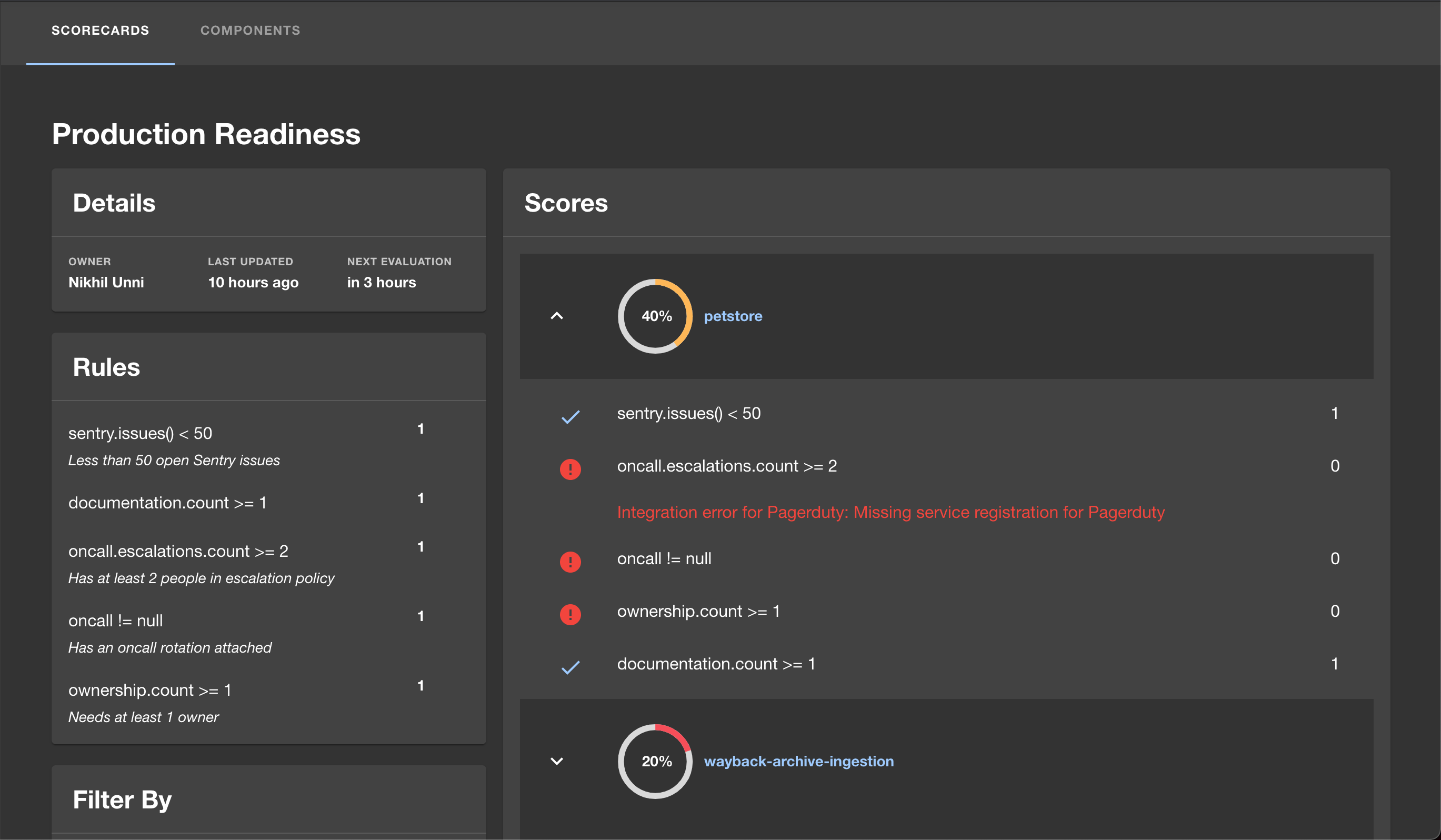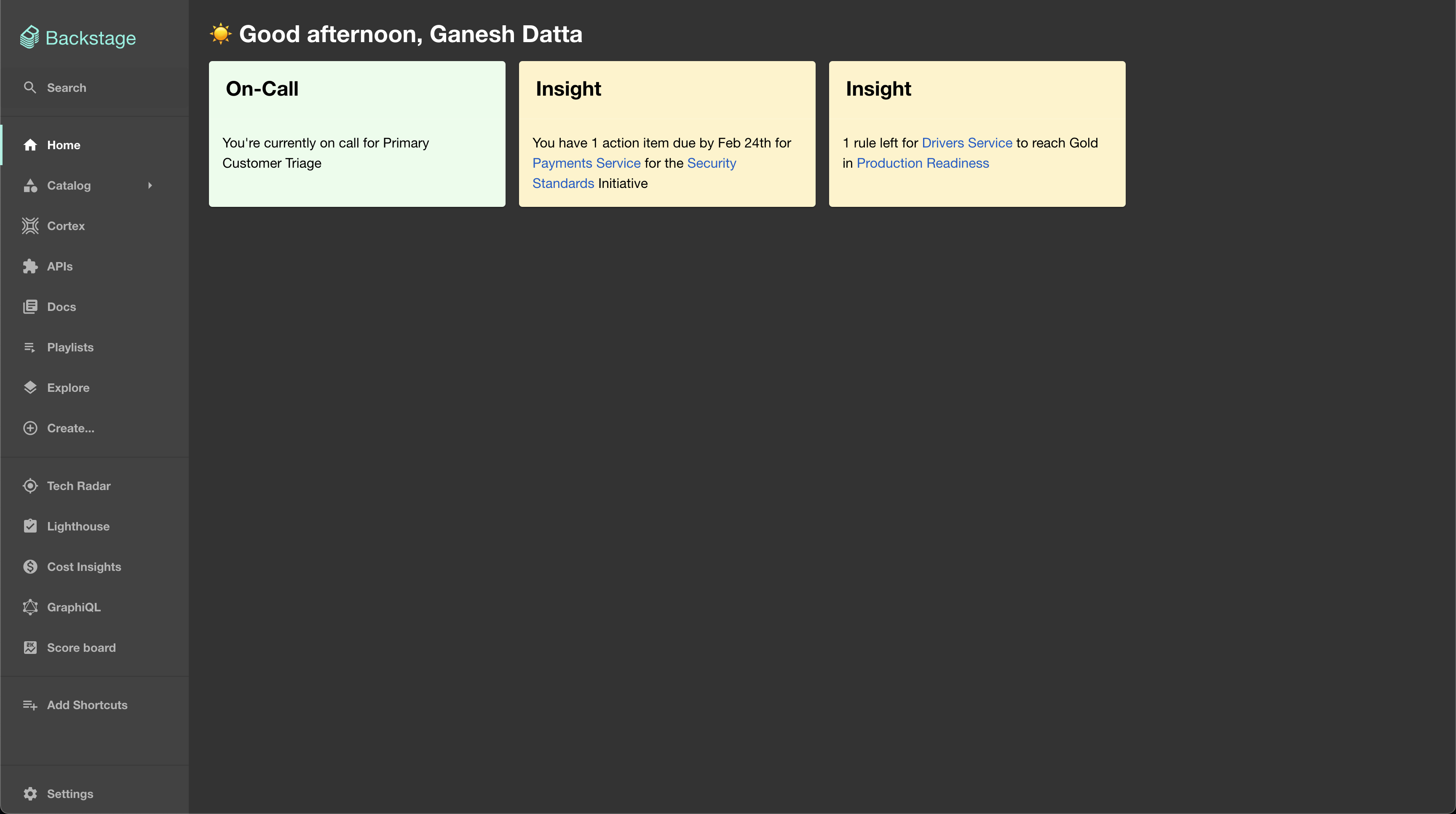Cortex makes it easy for engineering organizations to gain visibility into their services and deliver high quality software.
We’ve released our Scorecards product as a Backstage plugin. Scorecards allow your team to define standards like production readiness and development quality, and enforce them without building scripts and maintaining spreadsheets.
- One-click integration with third-party tools: Scorecards fetch data automatically from your integrations without manual work, letting you easily enforce standards across all your tools.
- The flexibility to meet your organization’s needs: Our robust APIs make it easy to use data from custom sources in your Scorecards. Cortex Query Language (CQL) enables you to create complex rules that can compare data across multiple sources or write expressive logical statements.
- Enable leaders to make informed decisions: Historical data and organizational summaries give leadership deep visibility into progress, bottlenecks, and areas of risk.
- Drive organizational progress with ease using Initiatives: Within any Scorecard, assign owners and due dates to drive any best-practice, platform migration, and audit needs.
The plugin automatically ingests your Backstage components and then lets you easily define standards and governance using our Scorecard editor. Scores are then piped back into Backstage through our plugin, so you can see the results directly in your Backstage service catalog. Developers never need to leave your Backstage portal to understand their action items and how to improve the quality of their services.
Scorecards are extremely flexible, letting you track and enforce anything custom, including:
- Security standards
- Production readiness
- Service maturity
- Platform and package migrations
- DORA metrics
Cortex creates personalized action items for service owners. These can be found in the Backstage UI or received through notifications via Slack and email.
To start using the Backstage plugin and see a demo, please book a demo!
For information on how to migrate between major versions, see the migration guide.
- In the packages/app directory of your backstage instance, add the plugin as a package.json dependency:
$ yarn add @cortexapps/backstage-plugin- Export the plugin in your app's plugins.ts to enable the plugin:
export { cortexPlugin } from '@cortexapps/backstage-plugin';- Import page to App.tsx:
import { CortexPage } from '@cortexapps/backstage-plugin';- And add a new route to App.tsx:
<Route path="/cortex" element={<CortexPage />} />- Update app-config.yaml to add a new config under
the
proxysection:
'/cortex':
target: ${CORTEX_BACKEND_HOST_URL}
headers:
Authorization: Bearer ${CORTEX_TOKEN}
allowedHeaders: ['x-cortex-email', 'x-cortex-name']- Import
EntityCortexContentand update EntityPage.tsx to add a new catalog tab for Cortex:
import { EntityCortexContent } from '@cortexapps/backstage-plugin';
<EntityLayout.Route path="/cortex" title="Cortex">
<EntityCortexContent />
</EntityLayout.Route>;- Add a new sidebar item in Root.tsx
import { CortexIcon } from '@cortexapps/backstage-plugin';
<SidebarItem icon={CortexIcon} to="cortex" text="Cortex" />;- (Optional) Import
CortexScorecardWidgetand update EntityPage.tsx to add a new component widget for Cortex that shows scorecards for that component:
import { CortexScorecardWidget } from '@cortexapps/backstage-plugin';
<Grid item md={4} xs={12}>
<CortexScorecardWidget />
</Grid>;- (Optional) Import
CortexGroupActionItemsWidgetand update EntityPage.tsx to add a new group widget for Cortex that shows initiative action items for components owned by that group:
import { CortexGroupActionItemsWidget } from '@cortexapps/backstage-plugin';
<Grid item md={4} xs={12}>
<CortexGroupActionItemsWidget />
</Grid>;- (Optional) Import
SystemCortexContentand update EntityPage.tsx to add a new catalog tab for Cortex:
<EntityLayout.Route path="/cortex" title="Cortex">
<SystemCortexContent />
</EntityLayout.Route>- (Optional) Update
app-config.yamlto point to a self-hosted instance.
cortex:
frontendBaseUrl: ${CORTEX_FRONTEND_HOST_URL}- (Optional) Update
app-config.yamlto hide the Settings page from all users, including admins.
cortex:
hideSettings: true- (Optional) When performing manual entity sync in the Settings page, you can choose to use gzip to compress the entities by updating
app-config.yamlwith the parametersyncWithGzip. You must also update the Backstage HTTP proxy to allow theContent-Encodingheader.
cortex:
syncWithGzip: trueproxy:
'/cortex':
target: ${CORTEX_BACKEND_HOST_URL}
headers:
Authorization: ${CORTEX_TOKEN}
allowedHeaders:
- Content-Encoding- (Optional) Customize Backstage homepage as the Cortex homepage:
- Import
CortexHomepageand update App.tsx:
import { CortexHomepage } from '@cortexapps/backstage-plugin';
<Route path="/" element={<HomepageCompositionRoot />}>
<CortexHomepage />
</Route>;- Update sidebar items in Root.tsx:
<SidebarItem icon={HomeIcon} to="/" text="Home" />See Backstage Homepage documentation for further details.
Note: we rely on Backstage's Identity API, specifically the email returned by getProfileInfo() for user-scoped requests.
You can configure the Cortex plugin to customize its layout. (And soon the ability to provide custom mappings to Cortex YAMLs.)
To do this, instead of importing cortexPlugin, CortexPage, and EntityCortexContent directly, you can inject custom behavior into the plugin like:
import {
CustomMapping,
EntityFilterGroup,
extendableCortexPlugin,
ExtensionApi,
} from '@cortexapps/backstage-plugin';
import { Entity } from '@backstage/catalog-model';
class ExtensionApiImpl implements ExtensionApi {
async getAdditionalFilters(): Promise<EntityFilterGroup[]> {
return [
{
name: 'Type',
groupProperty: (entity: Entity) =>
entity.spec?.type === null || entity.spec?.type === undefined
? undefined
: [JSON.stringify(entity.spec?.type).replaceAll('"', '')],
},
];
}
async getCustomMappings(): Promise<CustomMapping[]> {
return [
(entity: Entity) => {
if (!componentEntityV1alpha1Validator.check(entity)) {
return {};
}
const component = entity as ComponentEntityV1alpha1;
const system = component.spec.system;
const serviceGroup = system ? `system:${system}` : undefined;
return {
'x-cortex-service-groups': [
...(component.metadata.tags ?? []),
...(serviceGroup ?? []),
],
};
},
];
}
}
export const { plugin, EntityCortexContent, CortexPage } =
extendableCortexPlugin({}, () => new ExtensionApiImpl());The extension above will insert Backstage spec types as a new filter type in many of the views -- and more filtering and aggregations with this configuration to follow.
Then, instead of importing/exporting from @cortexapps/backstage-plugin directly, you can use these new extended exports instead:
export { plugin } from './cortex';import { CortexPage } from './cortex';import { EntityCortexContent } from '../../cortex';


